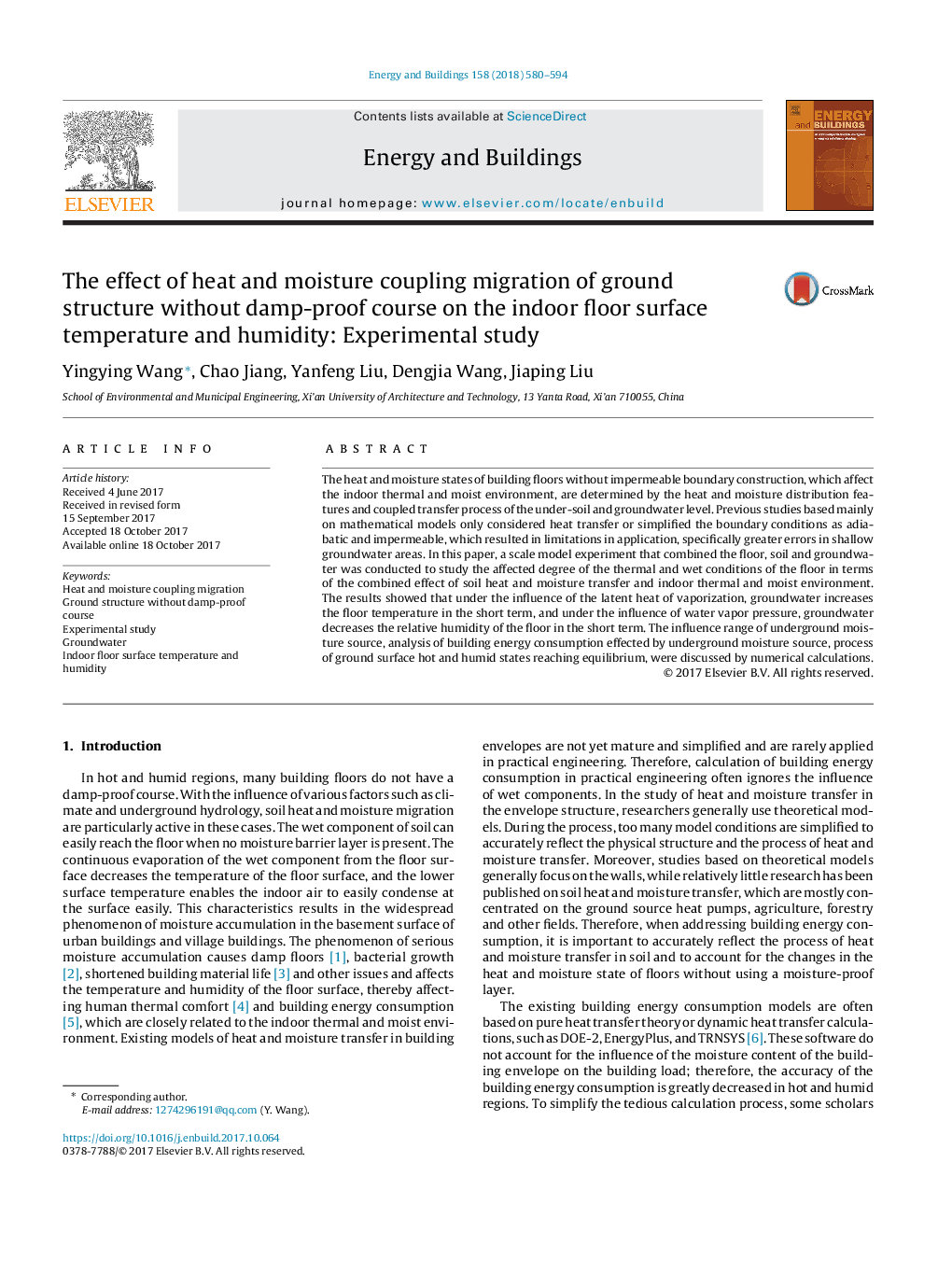| کد مقاله | کد نشریه | سال انتشار | مقاله انگلیسی | نسخه تمام متن |
|---|---|---|---|---|
| 6729444 | 1428932 | 2018 | 15 صفحه PDF | دانلود رایگان |
عنوان انگلیسی مقاله ISI
The effect of heat and moisture coupling migration of ground structure without damp-proof course on the indoor floor surface temperature and humidity: Experimental study
ترجمه فارسی عنوان
اثر مهاجرت حرارتی و رطوبتی ساختار زمین بدون دوره مقاوم در برابر حرارت بر سطح دما و رطوبت در سطح سرپوینده: مطالعه تجربی
دانلود مقاله + سفارش ترجمه
دانلود مقاله ISI انگلیسی
رایگان برای ایرانیان
کلمات کلیدی
مهاجرت حرارت و رطوبت، ساختار زمین بدون دوره مقاوم در برابر نفوذ، مطالعه تجربی، آب های زیرزمینی، دمای سطح و دمای رطوبت کف داخل ساختمان،
ترجمه چکیده
شرایط گرمایی و رطوبت کف ساختمان بدون ساختار مرزی نفوذ ناپذیر که محیط محیط حرارتی و مرطوب را تحت تأثیر قرار می دهد، به واسطه ویژگی های توزیع گرما و رطوبت و روند انتقال همراه با سطح زیرزمینی و زیرزمینی تعیین می شود. مطالعات قبلی که عمدتا بر اساس مدل های ریاضی بود فقط انتقال گرما را در نظر گرفتند و شرایط مرزی را به عنوان آسیابیابی و غیر قابل نفوذ ساده تر کردند، که منجر به محدودیت در کاربردها شد، بویژه خطاهای بیشتر در مناطق زیرزمینی کم عمق. در این مقاله، یک آزمایش مدل مقیاس که در آن کف، خاک و آبهای زیرزمینی ترکیب شده است، برای بررسی درجه حرارت تحت تاثیر شرایط حرارتی و مرطوب کف از نظر ترکیب اثر گرما و رطوبت خاک و محیط حرارتی و مرطوب در محیط داخلی . نتایج نشان داد که تحت تاثیر گرمای پنهان تبخیر، آب های زیرزمینی در کوتاه مدت به دمای زمین می انجامد و تحت تاثیر فشار بخار آب، آب های زیرزمینی رطوبت نسبی کف را در کوتاه مدت کاهش می دهد. محدوده نفوذ منبع رطوبت زیرزمینی، تجزیه و تحلیل مصرف انرژی ساختمان با استفاده از منبع رطوبت زیرزمینی، روند سطح زمین گرم و مرطوب به دست آوردن تعادل، با استفاده از محاسبات عددی مورد بحث قرار گرفت.
موضوعات مرتبط
مهندسی و علوم پایه
مهندسی انرژی
انرژی های تجدید پذیر، توسعه پایدار و محیط زیست
چکیده انگلیسی
The heat and moisture states of building floors without impermeable boundary construction, which affect the indoor thermal and moist environment, are determined by the heat and moisture distribution features and coupled transfer process of the under-soil and groundwater level. Previous studies based mainly on mathematical models only considered heat transfer or simplified the boundary conditions as adiabatic and impermeable, which resulted in limitations in application, specifically greater errors in shallow groundwater areas. In this paper, a scale model experiment that combined the floor, soil and groundwater was conducted to study the affected degree of the thermal and wet conditions of the floor in terms of the combined effect of soil heat and moisture transfer and indoor thermal and moist environment. The results showed that under the influence of the latent heat of vaporization, groundwater increases the floor temperature in the short term, and under the influence of water vapor pressure, groundwater decreases the relative humidity of the floor in the short term. The influence range of underground moisture source, analysis of building energy consumption effected by underground moisture source, process of ground surface hot and humid states reaching equilibrium, were discussed by numerical calculations.
ناشر
Database: Elsevier - ScienceDirect (ساینس دایرکت)
Journal: Energy and Buildings - Volume 158, 1 January 2018, Pages 580-594
Journal: Energy and Buildings - Volume 158, 1 January 2018, Pages 580-594
نویسندگان
Yingying Wang, Chao Jiang, Yanfeng Liu, Dengjia Wang, Jiaping Liu,
